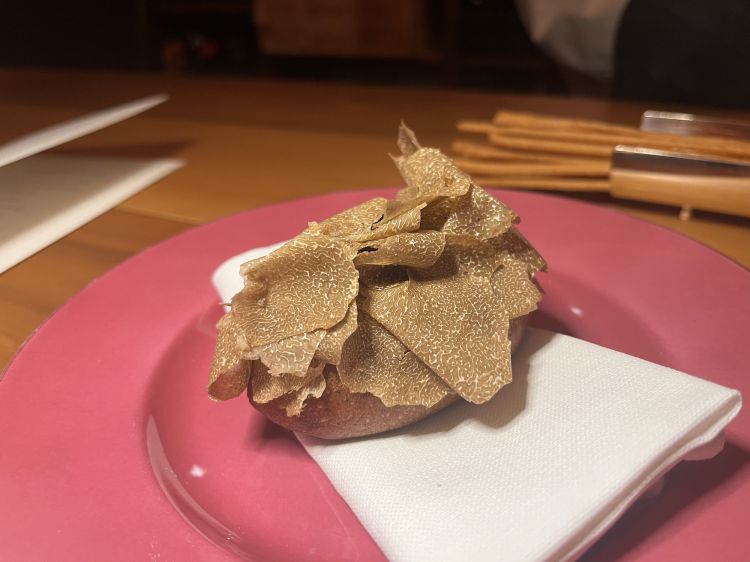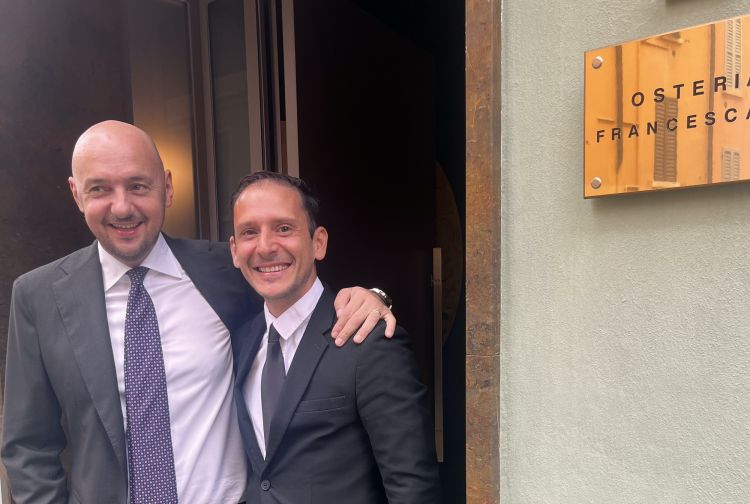'A Tuscan who tries his hand at a Memory of a mortadella sandwich can only put finocchiona on it. A Korean who decides to make Tortellini that walk on broth turns them into dumplings that rise like Seoul skyscrapers...'. A few months after the debut of "I am not there", Massimo Bottura enjoys the daily fully booked Osteria Francescana, reiterating with his usual electricity the intimate sense of the current menu: ‘These are all dishes from our history, completely rewritten by the sensitivities and inclinations of our young team. We are breaking 40 years of work with their cultural biodiversity.’
If at the time we had already detailed the main technical notes of the menu we would now like to add a few further notes and ideas.
1) The Five ages of Parmigiano Reggiano in different textures and temperatures, the Potato that wants to become a truffle, the Eel that goes up the Po, the Grey and black risotto... Reading the sequence of the menu (the photos of the dishes are at the bottom) one thought immediately comes to mind: in the quarter of a century that has changed the look of cuisine, we all have a clearer or lesser understanding - having tried them or even just seen them online - of the name and composition of several Francescana dishes. Few chefs in the world have been able to breach the imagination of new foodies as effectively.
2) In Massimo Bottura's vision, a signature dish is never complete or unchangeable but always in transit: when his most famous dish was conceived for the first time in 1994, there were three ages of Parmigiano. Over time, there’ve reached five and we remember well when the Modenese chef entered the room with a still puffing out a "fog" of Parmigiano (it should have been the sixth texture and who knows if it will become one). Five ages is also on the current menu, but it’s now called Textures of milk and grass and it has something to do (and it hasn’t) with its illustrious predecessor: the new accents (rennet and hay mousse, chlorophyll cream...) take us back to the biological cycle of the animal because ‘if Parmigiano is good it is only because the cow has been treated well,’ explains the chef. The moral: the signature dish only becomes eternal if you re-discuss it every time; not if you keep offering it identically over the years. It’s a thought that puts to rest the recurring debate of copyright in the kitchen: to exercise it over a dish is to halt its evolution, to announce its clinical death.
3) We closed our eyes when tasting the Cesar Salad that becomes a pasta salad; the Potato/truffle served on a napkin like a Montreal-style boiled bun; the Compression of pasta and beans, Mullet and scampi and Camouflage - three emblematic recipes from Via Stella - merged in a single dish (Camouflage Mediterraneo): "I'm not there" is a very good menu because it revolutionises the most famous and celebrated recipes. Better, it writes important variations on well-known bases. It is a brave menu, on a par with "With a little help from a friend" (2021), the one with which Bottura&friends rewrote the connotations not of their own, but of the iconic dishes of Italian fine dining, from Gualtiero Marchesi's spaghetti and caviar salad to Mirella Catantarelli's Savarin di riso, from Nadia Santini's pumpkin tortelli to Gianfranco Vissani's cold Carbonara. ‘Change keeps me alive’: it is a restlessness that does credit to the chef, who could serenely rest on his laurels and instead shuffles the cards continuously, transforming local ingredients with ever changing inspirations. And that give value to the ideas of the team, moving the field of investigation far beyond narrow, provincial visions.
4) Courage also means never getting sucked into the whirlpool of homologation, political correctness or what 'should' be communicated in this precise historical time: the veg-mania for instance does not capture the Osteria Francescana which, with This little piggy went to the market, at the peak of the tasting menu, serves a Neapolitan black pudding (!) on a layered piglet. ‘Sustainability,’ explains Bottura, ‘is in our heads.’ Not in doing what everyone else does.
5) Speaking of sauces, we think that, from a purely technical point of view, one of the most relevant contributions of Osteria Francescana is the enormous work on sauces: over the years, we have found whipped spaghetti creams, herb sauces, mushroom broths, brown bases of toasted rice, mallard or fallow deer bones, criolle and caciucco sauces, fennel mole or chowder... It is a formidable reservoir of new-takes on classics and progressive removals of fatty elements, a technical heritage that would deserve a story itself.
6) ‘The ingredient of the future is culture.’ How many times have we heard Massimo Bottura say this? At every congress or public event. It is an invitation, disregarded by emulators, however, for whom 'culture' all too often means slavishly paying homage to Lucio Fontana's cuts on canvas, quoting Warhol, Pollock or Thelonius Monk in various capacities, necessarily giving their own version of a metamorphic dish (the rampant 'x that wanted to become y'). Culture means persistently frequenting other worlds in order to give oneself a style (and perhaps impose it); striving to see things with new eyes, not clumsily aping what others do. ‘If I have expressive doubts,’ explains Bottura, ‘I almost always just read a page of Céline or listen to a verse by Bob Dylan.’
The end of this piece is about a new piece of news. We tried to get some details about Gatto Verde, Bottura's new restaurant in Modena, ‘one of the most sustainable restaurants in the world,’ he announced on stage at Identità Golose Milano. When will it open? ‘I can't say because I always like to announce things when the project is finished. I can tell you that the green cat is an important subject in the Parisian Surrealism of the 1920s but it was also the name of the restaurant where Enzo Ferrari used to take his family on Sundays...’. Where will it open? We insist. ‘Maybe here, maybe there,’ he muddies the waters in full I'm not there style, ‘they said at the San Venanzio bend but it's not true. In the centre of Modena?’ No, here there will only ever be Francescana. Anything can happen when the cat turns green. Fire fire everywhere! ’
OSTERIA FRANCESCANA, menu "I'm not there"

Massimo Bottura, 60. The opening triptych of the menu 'I'm not There' (€325) is immediately a micronisation of 3 iconic Osteria Francescana dishes: Normandy, Memory of a Mortadella Sandwich and The Eel Swimming Up the Po River

A Potato that Wants to Become a Truffle

Camouflage Mediterraneo: Triglia e Scampi e Una Trota in Nero

Cesar Salad as a Pasta (photo by Paolo Terzi)

La Vie en Rose (foto di Paolo Terzi)

This Little Piggy Went to the Market

Consistenze di Latte ed Erba

Final tastings. Capri Battery, Better than Popcorn as Croccantino and Un Boccone di Sud

Giuseppe Palmieri (restaurant manager and sommelier) and Andrea Garelli, pillars of the Osteria Francescana front of house (we spoke at the time about how the front of house works).
The wine pairing of the "I'm Not There" menu (210 euros):
Picolit 2021 Marco Sara
Mareneve 2020 Federico Graziani
Fonte Canale 2020 Cristiana Tiberio
Rebaldo (gin, soda, vanilla salt)
Riesling Kabinett 2021 Fritz Haag
Prunent 2020 Cantine Garrone
Ribolla 2019 Damijan Podversic
Indio 2021 Negretti

Palmieri and Bottura, together for 23 years
Translated into English by Slawka G. Scarso